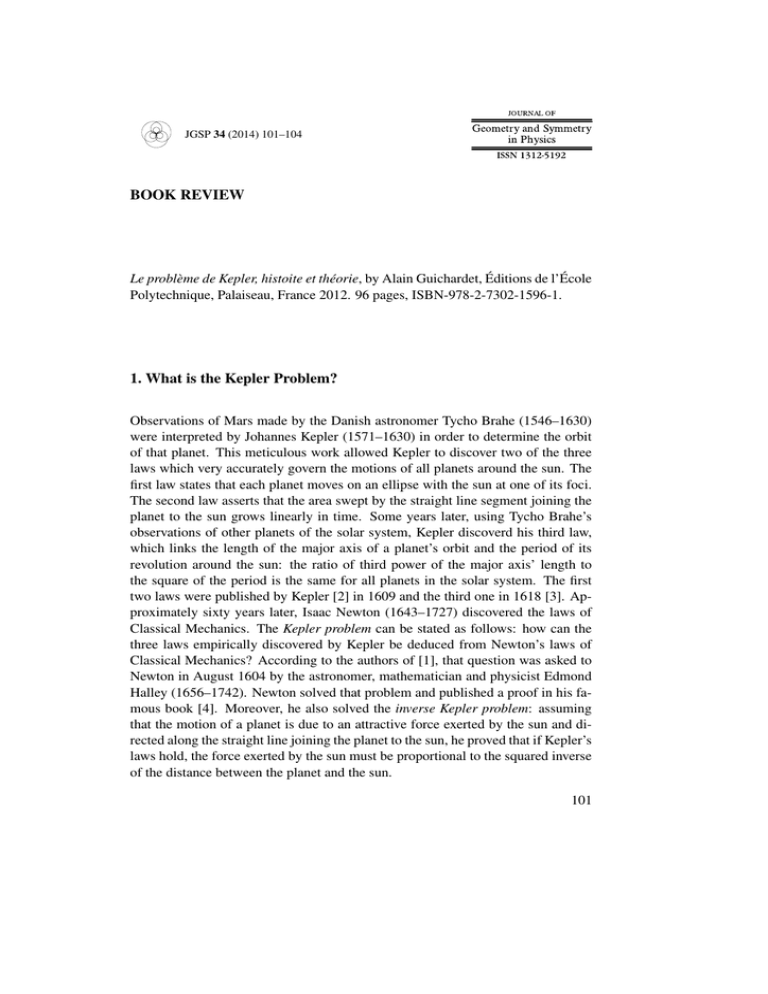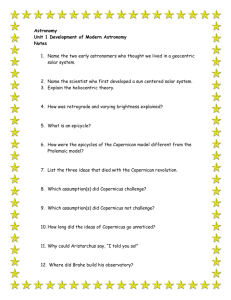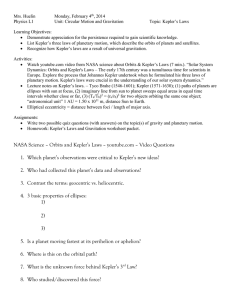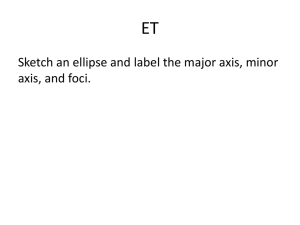BOOK REVIEW 1. What is the Kepler Problem?
advertisement

JGSP 34 (2014) 101–104 BOOK REVIEW Le problème de Kepler, histoite et théorie, by Alain Guichardet, Éditions de l’École Polytechnique, Palaiseau, France 2012. 96 pages, ISBN-978-2-7302-1596-1. 1. What is the Kepler Problem? Observations of Mars made by the Danish astronomer Tycho Brahe (1546–1630) were interpreted by Johannes Kepler (1571–1630) in order to determine the orbit of that planet. This meticulous work allowed Kepler to discover two of the three laws which very accurately govern the motions of all planets around the sun. The first law states that each planet moves on an ellipse with the sun at one of its foci. The second law asserts that the area swept by the straight line segment joining the planet to the sun grows linearly in time. Some years later, using Tycho Brahe’s observations of other planets of the solar system, Kepler discoverd his third law, which links the length of the major axis of a planet’s orbit and the period of its revolution around the sun: the ratio of third power of the major axis’ length to the square of the period is the same for all planets in the solar system. The first two laws were published by Kepler [2] in 1609 and the third one in 1618 [3]. Approximately sixty years later, Isaac Newton (1643–1727) discovered the laws of Classical Mechanics. The Kepler problem can be stated as follows: how can the three laws empirically discovered by Kepler be deduced from Newton’s laws of Classical Mechanics? According to the authors of [1], that question was asked to Newton in August 1604 by the astronomer, mathematician and physicist Edmond Halley (1656–1742). Newton solved that problem and published a proof in his famous book [4]. Moreover, he also solved the inverse Kepler problem: assuming that the motion of a planet is due to an attractive force exerted by the sun and directed along the straight line joining the planet to the sun, he proved that if Kepler’s laws hold, the force exerted by the sun must be proportional to the squared inverse of the distance between the planet and the sun. 101 102 Book Review 2. The Book by Alain Guichardet Although solved over three centuries ago, the Kepler problem has, up to now, continuously given birth to many famous mathematicians’ and physicists’ studies. In his very stimulating short book, Alain Guichardet explains some of the reasons of this persisting interest. He discuss some works dedicated to the Kepler problem published during the last three centuries and brings some light on the related mathematical and physical theories including differential geometry, Hamiltonian systems, actions of Lie groups and of Lie algebras, classical and quantum Mechanics. He thoroughly explains the formulae which govern the planet’s motions around the sun. His work is structured as Introduction and three Chapters. In the Introduction he explains the persistence of mathematicians’ and physicists’ interest in the Kepler problem, on the one hand by the evolution of the mathematical techniques, on the other hand, since 1920, by the inception of quantum Mechanics. In the framework of this new theory, studies of the properties of the hydrogen atom use a scheme very similar to that used for dealing with the motion of a planet around the sun. The first Chapter, entilted History, is about the evolution of methods used to study the Kepler problem in the last three centuries. The author shortly describes the works of the founders: Johannes Kepler, Isaac Newton, Jakob Herman (1678– 1733), Johann Bernoulli (1667–1748). Curiously enough, Newton being, with Wilhelm Leibniz (1646–1716), the inventor of Differential Calculus, it is by geometrical methods that in his book [4] he solves the Kepler problem. Alain Guichardet does not reproduce this solution, but shows the drawing used by Newton to solve the inverse Kepler problem. Although the notion of a vector was not yet known, Jakob Herman discovered the vector-valued first integral today called the eccentricity vector (sometimes imploperly called the Laplace vector or the Runge–Lenz vector). Alain Guichardet uses it abundantly in his second Chapter. With Joseph-Louis Lagrange (1736–1813), Pierre-Simon de Laplace (1749–1827) and William Rowan Hamilton (1805–1865), geometrical methods are superseded by Analysis and Differential Calculus, which become the main mathematical tools used in relation with the Kepler problem. New ideas appeared during the XX-th century with the study, in the framework of quantum Mechanics, of the emission spectrum of the hydrogen atom and of the multiplicities of eigenvalues of its energy operator. Alain Guichardet shortly describes Wilhelm Lenz’s (1888–1957), Wolfgang Pauli’s (1900–1958), L. Hulthén’s, Vladimir Fock’s (1898–1974), M. Bander’s and Claude Itzykson’s (1938–1995) contributions, as well as some other works published from 1966 to 2010 related Book Review 103 to the classical (non quantum) Kepler problem, aiming at the determination of its hidden symmetries related to the eccentricity vector. In the second Chapter, Theory, Alain Guichardet describes the “natural” configuration and phase spaces of the Kepler problem. He gives the expressions of the Hamiltonian function of the system and of its two vector-valued first integrals: the angular momentum and the eccentricity vector. He also gives a thorough description of all the negative energy motions (those whose orbits are ellipses). He carefully defines the three anomalies (eccentric, true and average) and fully derives the three Kepler’s laws. Rather than using the eccentricity vector itself, he uses its quotient by the energy, which allows the grouping of the two vector-valued first integrals into a single six-dimensional first integral, which later will appear as the momentum map of a Hamiltonian action of the rotation group in the fourdimensional Euclidean vector space. However, this method has a drawback: it excludes the zero energy motions, those whose orbits are parabolas. Alain Guichardet then describes T ∗ S 3 , the cotangent bundle to a three-dimensional sphere S 3 . He defines a map from the Kepler problem’s natural phase space to that cotangent bundle relating integral curves of the Kepler problem and the canonical lifts to the cotangent bundle of the parametrized geodesics of S 3 . After compactification of the energy surfaces, he obtains a one-to-one correspondence between the integral curves of the regularized Kepler problem (restricted to motions of negative energy) and the integral curves of the natural Hamiltonian on T ∗ S 3 . The sixdimensional first integral of the Kepler problem grouping the angular momentum and the eccentricity vector (divided by the energy) then appears as the momentum map of the action of SO(4) on T ∗ S 3 . The second chapter ends with a short presentation of Bander’s and Itzykson’s results about the hydrogen atom. In Chaper 3, Appendices, the author shortly describes the principle notions from Differential Geometry, Lie groups, Lie algebras, classical and quantum Mechanics, used in the previous chapter. He also mentions various developments of the Kepler problem: motions of positive energy, actions of higher dimensional Lie groups, the N -bodies problem, . . . 3. Conclusion Many other works dealing with the Kepler problem are available. Several of them are indicated in the reference list of Alain Guichardet’s book. Allow me to mention one more: Richard Feynman’s, David and Judith Goodstein’s “The Motion Conventionnally the zero energy level is that of a planet at rest infinitely far from the sun. 104 Book Review of Planets Around the Sun” short book [1]. Readers fond of Classical Geometry will find in it, in addition to moving memories of the eminent physicist and teacher Richard Feynman (1918–1988), a beautiful solution of the Kepler problem which only uses elementary geometric properties of conical sections. With Alain Guichardet’s book the readers will take an exciting trip through the history of Mathematics and Physics in the three last centuries. Readers curious to understand the ways in which scientific progresses occur will be deeply interested in it. It will also provide a good initiation to the study of Differential Geometry, Lie groups and Lie algebras, classical and quantum Mechanics. Its well developed and carefully organized reference list will be a precious help for readers to make their way through the published scientific literature. References [1] Feynman R., In: Goodstein D. and Goodstein J., Feynman’s Lost Lecture: The Motion of Planets Around the Sun. W.W. Norton and Co., 1966. French translation: Le mouvement des planètes autour du soleil. Éditions Cassini, Paris 1996. [2] Kepler J., Astronomia nova (in Latin), 1609. French translation: Astronomie nouvelle. Éditions Albert Blanchard, Paris 1979. [3] Kepler J., Harmonice mundi (in Latin), 1619. French translation: L’harmonie du monde. Éditions Albert Blanchard, Paris 1979. [4] Newton I., Philosophia Naturalis Principia Mathematica, London 1687. French translation by Émilie du Chastelet 1756. Charles-Michel Marle retired from Institut de Mathématiques Université Pierre et Marie Curie Home address: 27, avenue du 11 novembre 1918 92190 Meudon, FRANCE E-mail address:charles-michel.marle@math.cnrs.fr







